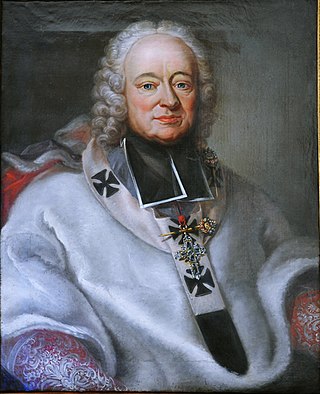Related Research Articles

The Society of Jesus, also known as the Jesuit Order or the Jesuits, is a religious order of clerics regular of pontifical right for men in the Catholic Church headquartered in Rome. It was founded in 1540 by Ignatius of Loyola and six companions, with the approval of Pope Paul III. The society is engaged in evangelization and apostolic ministry in 112 nations. Jesuits work in education, research, and cultural pursuits. Jesuits also conduct retreats, minister in hospitals and parishes, sponsor direct social and humanitarian ministries, and promote ecumenical dialogue.

Pope Clement XIV, born Giovanni Vincenzo Antonio Ganganelli, was head of the Catholic Church and ruler of the Papal States from 19 May 1769 to his death in September 1774. At the time of his election, he was the only Franciscan friar in the College of Cardinals, having been a member of OFM Conventual. He is the most recent pope to take the pontifical name of "Clement" upon his election.

The Bollandist Society is an association of scholars, philologists, and historians who since the early seventeenth century have studied hagiography and the cult of the saints in Christianity. Their most important publication has been the Acta Sanctorum. They are named after the Flemish Jesuit Jean Bollandus (1596–1665).

The suppression of the Society of Jesus was the removal of all members of the Jesuits from most of Western Europe and their respective colonies beginning in 1759 along with the abolition of the order by the Holy See in 1773; the papacy acceded to said anti-Jesuit demands without much resistance. The Jesuits were serially expelled from the Portuguese Empire (1759), France (1764), the Two Sicilies, Malta, Parma, the Spanish Empire (1767) and in Austria and Hungary (1782).

Diego Laynez, S.J., born in 1512 and died on 19 January 1565 (Rome), was a Spanish Jesuit priest and theologian, a New Christian, and the second Superior General of the Society of Jesus after the founder Ignatius of Loyola.

Peter Canisius was a Dutch Jesuit priest. He became known for his strong support for the Catholic faith during the Protestant Reformation in Germany, Austria, Bohemia, Moravia, Switzerland and the British Isles. The restoration of the Catholic Church in Germany after the Protestant Reformation is largely attributed to the work there of the Society of Jesus, which he led. He is venerated in the Catholic Church as a saint and as a Doctor of the Church.
Pierre Millet (Milet) was a French Jesuit missionary to the Iroquois people in the area that is now New York State.

Péter Pázmány de Panasz, S.J., was a Hungarian Jesuit who was a noted philosopher, theologian, cardinal, pulpit orator and statesman. He was an important figure in the Counter-Reformation in Royal Hungary.
Mieczysław Halka-Ledóchowski, was born in Górki in Russian-controlled Congress Poland to Count Josef Ledóchowski and Maria Zakrzewska. He was uncle to Saint Ursula Ledóchowska, the Blessed Maria Teresia (Theresa) Ledóchowska and Father Włodzimierz Ledóchowski, General Superior of the Society of Jesus.

Charles Lallemant, SJ was a French Jesuit missionary. He was born in Paris in 1587 and later became the first superior of the Jesuit Missions amongst the Huron in Canada. His letter to his brother, dated August 1, 1626, inaugurated the series Relations des Jésuites de la Nouvelle-France about the missionary work in the North American colonies of New France.
Louis Lallemant was a French Jesuit.

The Keys of Heaven, also called Saint Peter's keys, refers to the metaphorical keys of the office of Saint Peter, the keys of Heaven, or the keys of the kingdom of Heaven. It is explicitly referenced in the Bible in Matthew 16:19.

Alphonsus Rodríguez was a Spanish Jesuit religious brother who is venerated as a saint in the Catholic Church.

Henri François Xavier de Belsunce de Castelmoron was a French Jesuit who served as Bishop of Marseille from 1709 until his death. He is remembered for his tireless efforts to relieve the suffering during the Great Plague of Marseille of 1720–21.
Peter Roh was a Swiss Jesuit preacher.

Alphonsus (Alonso) Rodriguez was a Spanish Jesuit priest and spiritual writer. His writings, a single book, underline much the ascetical dimension of religious life.

Jesuit “conspiracy theories” are conspiracy theories about the members of the Society of Jesus (Jesuits), a religious order in the Catholic Church. Such theories began appearing as early as 1550, just ten years after the founding of the Jesuits. They were often accused by their enemies due to the intellectual and political influence the Society of Jesus exerted against others.

The 1769 papal conclave, was convoked after the death of Pope Clement XIII. It elected as his successor Cardinal Lorenzo Ganganelli, who took the name Clement XIV.
References
- ↑ Healy, Roisin (1969), The Jesuit Specter in Imperial Germany, Brill Press, p. 182, ISBN 0-391-04194-0 As part of the Studies in Central European Histories series edited by Thomas A. Brady Jr. and Roger Chickering
- ↑ Pavone, Sabina (2005), The Wily Jesuits and the Monita Secreta, Institute of Jesuit Sources, p. 10, ISBN 1880810603
- 1 2 3 Gerard, John. "Monita Secreta." The Catholic Encyclopedia Vol. 10. New York: Robert Appleton Company, 1911. 10 June 2016
- ↑ Gerard, John (1911). . Catholic Encyclopedia . Vol. 10.
- 1 2 Bernauer, James. "From European Anti-Jesuitism to German Anti-Jewishness: A Tale of Two Texts" presented at the Jagiellonian University, Kraków, Poland (March 5, 2009)
- ↑ Macaulay, Thomas Babington (1878). The History of England from the Accession of James II. Vol. II. Philadelphia: J. B. Lippincott & Co. p. 76.
- Attribution
 This article incorporates text from a publication now in the public domain : Herbermann, Charles, ed. (1911). "Monita Secreta". Catholic Encyclopedia . Vol. 10. New York: Robert Appleton Company.
This article incorporates text from a publication now in the public domain : Herbermann, Charles, ed. (1911). "Monita Secreta". Catholic Encyclopedia . Vol. 10. New York: Robert Appleton Company.